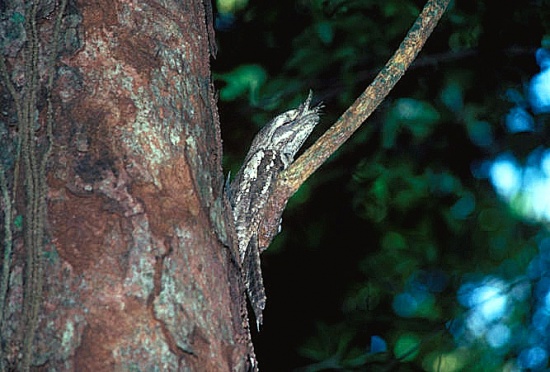| (13 intermediate revisions by 6 users not shown) | |||
| Line 1: | Line 1: | ||
| − | + | [[Image:Marbled_Frogmouth.jpg|thumb|550px|right|Subspecies ''marmoratus''. Photo by '''[http://www.birdforum.net/member.php?u=49168 Hans&Judy Beste]'''<br />Location: Iron Range, Cape York Peninsula, far north [[Queensland]]]] | |
| − | [[Image:Marbled_Frogmouth.jpg|thumb|550px|right|Photo by Hans & Judy Beste]] | + | ;[[:Category:Podargus|Podargus]] ocellatus |
==Identification== | ==Identification== | ||
| − | + | Rich brown plumage, flecked with black and white. Long, graduated tail and tuft of cream and chestnut-banded plumes protruding above the bill. | |
| − | |||
| − | |||
| − | |||
| − | |||
| − | |||
==Distribution== | ==Distribution== | ||
| − | + | [[Australia]] and [[New Guinea]]. | |
==Taxonomy== | ==Taxonomy== | ||
| + | Several subspecies accepted: | ||
| + | *''P.o. ocellatus'' | ||
| + | *''P.o. intermedius'' | ||
| + | *''P.o. meeki'' | ||
| + | *''P.o. marmoratus'' | ||
| + | *''P.o. plumiferus'' | ||
| + | [[Solomons Frogmouth]] (or Cinnamon Frogmouth) ''Rigidipenna inexpectata'' was formerly treated as subspecies of this species. | ||
| + | |||
==Habitat== | ==Habitat== | ||
| − | + | Subtropical rainforest from which they may fourage into neighboring woodlands. | |
| − | |||
==Behaviour== | ==Behaviour== | ||
| + | Fouraging primarily along tracks, streams, etc. | ||
| + | ==References== | ||
| + | #{{Ref-Clements6thDec09}}# Pizzey, G. & Knight, F. 1997. Birds of Australia (Collins Field Guide). HarperCollins Publishers, London. ISBN 0-00-220132-1 | ||
| + | #[http://birdforum.net/showthread.php?p=1874287 Birdforum thread] discussing taxonomy of Nightjars and Frogmouths. | ||
==External Links== | ==External Links== | ||
| − | + | {{GSearch|Podargus+ocellatus}} | |
| − | [[Category:Birds]] | + | |
| + | [[Category:Birds]][[Category:Podargus]] | ||
Latest revision as of 21:44, 12 February 2017

Subspecies marmoratus. Photo by Hans&Judy Beste
Location: Iron Range, Cape York Peninsula, far north Queensland
Location: Iron Range, Cape York Peninsula, far north Queensland
- Podargus ocellatus
Identification
Rich brown plumage, flecked with black and white. Long, graduated tail and tuft of cream and chestnut-banded plumes protruding above the bill.
Distribution
Australia and New Guinea.
Taxonomy
Several subspecies accepted:
- P.o. ocellatus
- P.o. intermedius
- P.o. meeki
- P.o. marmoratus
- P.o. plumiferus
Solomons Frogmouth (or Cinnamon Frogmouth) Rigidipenna inexpectata was formerly treated as subspecies of this species.
Habitat
Subtropical rainforest from which they may fourage into neighboring woodlands.
Behaviour
Fouraging primarily along tracks, streams, etc.
References
- Clements, JF. 2009. The Clements Checklist of Birds of the World. 6th ed., with updates to December 2009. Ithaca: Cornell Univ. Press. ISBN 978-0801445019.
- Pizzey, G. & Knight, F. 1997. Birds of Australia (Collins Field Guide). HarperCollins Publishers, London. ISBN 0-00-220132-1
- Birdforum thread discussing taxonomy of Nightjars and Frogmouths.



